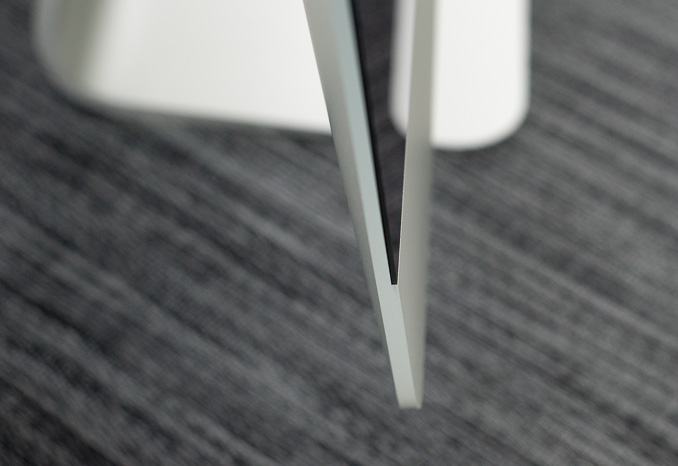21.5-inch iMac (Late 2013) Review: Iris Pro Driving an Accurate Display
by Anand Lal Shimpi on October 7, 2013 3:28 AM ESTFinal Words
Apple continues to have the strongest Mac lineup of its history. While I’m expecting something pretty cool with Broadwell next year, Apple’s Haswell Mac lineup continues to be an evolutionary improvement over the systems that were introduced last year.
The iMac’s industrial design is beautiful. I’m not sure I’m happy with the bezel thickness around the display, but otherwise I’m happy with the way Apple’s 2012 redesign turned out. Particularly with the 21.5-inch model, the compactness of the new iMac is pretty awesome. It’s a lot like the benefits of having a lightweight LCD TV - you only appreciate it when you have to move the thing, but it’s nice to have regardless of how rarely you move it.
Although I didn’t talk about this in the review, the in box wireless peripherals both work well. Combined with the fact that you can get 500Mbps file transfers over 802.11ac (over short distances, with Mavericks), you can really use the iMac with only a single cable and be pretty happy. Toss in Apple’s new 802.11ac Airport Extreme and you’ll have great wireless range as well.
The iMac’s out of box display experience is nothing short of incredible. Imaging professionals in dire need of color accuracy can walk into an Apple store, walk out with the entry-level iMac and have a remarkable experience. I’d love to see a higher resolution panel, but 4K panel pricing isn’t quite low enough yet (not to mention the possibility of Apple wanting to go 5K on its 27-inch display).
I wouldn’t touch either of the iMacs in their default configuration. Thankfully the upgrade to Fusion Drive or an SSD starts at $200, and is a must have. Fusion Drive remains the only solid state hybrid solution I’d touch. If you need a single volume, it’s absolutely the way to go.
CPU performance of the entry-level iMac really is very good. Power users can stand to go for one of the higher-end configurations, particularly if you’re running heavily threaded workloads. Lighter users should enjoy really good single threaded performance out of the base configuration however.
The entry-level iMac offers better integrated graphics performance than we’ve ever seen before, but true gamers will want to spring for a discrete GPU. Iris Pro under OS X (non-gaming) works well and I couldn’t really tell that I wasn’t using discrete graphics.
Thermals aren’t a concern with the base 21.5-inch iMac. The Core i5-4570R had no issues turbo-ing up to 3.0/3.1GHz on a regular basis, and the system fan never ramped up beyond 1400RPM during my testing. Overall the new 21.5-inch iMac is a very compact, cool and quiet machine. The 21.5-inch model in particular is an easy recommendation for anyone looking to get into a Mac desktop. Just make sure to order it with a Fusion Drive or SSD.












127 Comments
View All Comments
Res1233 - Wednesday, October 30, 2013 - link
Mac OS X is the main reason I buy macs. I have a feeling that you are right about most mac users having no clue what they're buying, but I could go on for hours about the advantages of OS X (geek-wise). No, hackintoshes are not an option if you want any kind of reliability, so don't even go there. If you force me to, I will explain my reasoning in depth to practically anandtech-levels, but I'm not in the mood right now. Perhaps another time! :)tipoo - Monday, October 7, 2013 - link
What are the chances of the 13" Pro duo getting Iris Pro 5200? I'd really love that.Bob Todd - Monday, October 7, 2013 - link
Have they announced any dual core Iris Pro parts? I know the original SKU list just had them in the quads. I still assume the 13" rMBP will get the 28W HD 5100 (hopefully in base configuration, but there will probably be a lower spec i5 below that).Flunk - Monday, October 7, 2013 - link
It's unsure, a new part could be announced at any time. Intel has even made variants specifically for Apple before.tipoo - Monday, October 7, 2013 - link
It shouldn't have to be dual core to be in the 13" pros though. Intel has quads in the same TDP as the current duals in it. A quad core, with GT3e, that would make it an extremely tempting package for me.Sm0kes - Tuesday, October 8, 2013 - link
I think anything but GT3e in the 13'' Macbook Pro is going to be a disappointment at this point. How their 13'' "pro" machine has gone this long with sub-par integrated graphics is mind boggling. The move to a retina display really emphasized the weakness.I'd also venture a guess that cost is the real barrier, as opposed to TDP.
tipoo - Thursday, October 10, 2013 - link
Perhaps. Yeah, the 13" has been disappointing to me, I love the form factor, but hate the standard screen resolution, and the HD4000 is really stretched on the Retina. If it stays a dual core, I don't see a whole lot of appeal over the Macbook Air 13" either. To earn that pro name, it really should be a quad with higher end integrated graphics.Hrel - Monday, October 7, 2013 - link
"This is really no fault of Apple’s, but rather a frustrating side effect of Intel’s SKU segmentation strategy."So I take it I'm not the only one infuriated by the fact that Intel hasn't made Hyperthreading standard on all of it's CPU's.
I remember reading, on this site, that HT adds some insignificant amount of die area, like 5% or something, but is capable of adding up to 50% performance. (in theory). If that's the case the ONLY reason to not include it on EVERY CPU is to nickel and dime your customers. Except it should really be "$100" your customers since only the i7's have HT.
Isn't the physical capability of HT already on ALL cpu's? It just needs to be turned on in firmware right?
DanNeely - Monday, October 7, 2013 - link
With the exception of IIRC dual vs quad core dies and GT2 vs GT3 graphics almost everything that differs between CPUs in a generation is either binning or disabling components if too few dies with a segment non-functional are available for the lower bin.Intel could differentiate its product line without doing any segment disabling on the dies; but it would require several times as many different die designs which would require higher prices due to having to do several times as much validation. Instead we get features en/disabled with fuses or microcode because the cost of the 'wasted' die area is cheaper than the costs associated with validating additional die configurations.
Flunk - Monday, October 7, 2013 - link
Actually the GT2 is just a die-harvested GT3. Intel only have 2 and 4 core versions and crystalwell is an add-on die so there are essentially only 2 base dies, at least for consumers.I do agree about the hyper-threading, there is really no need to disable it. It's not like it really matters in consumer applications anyway.